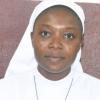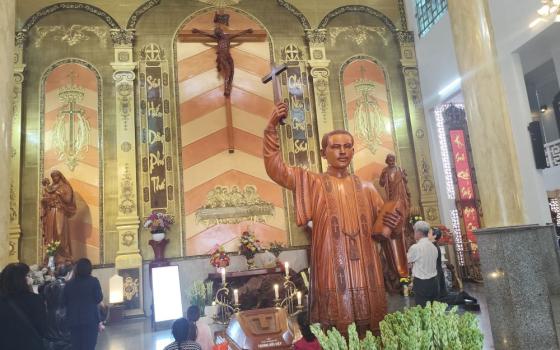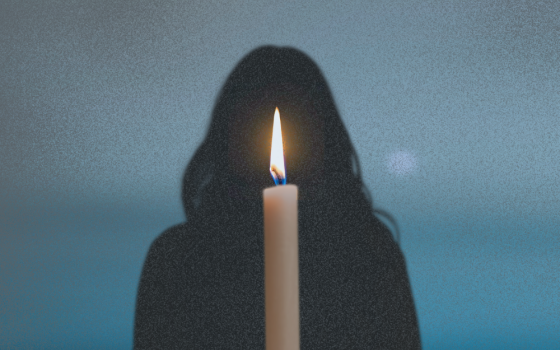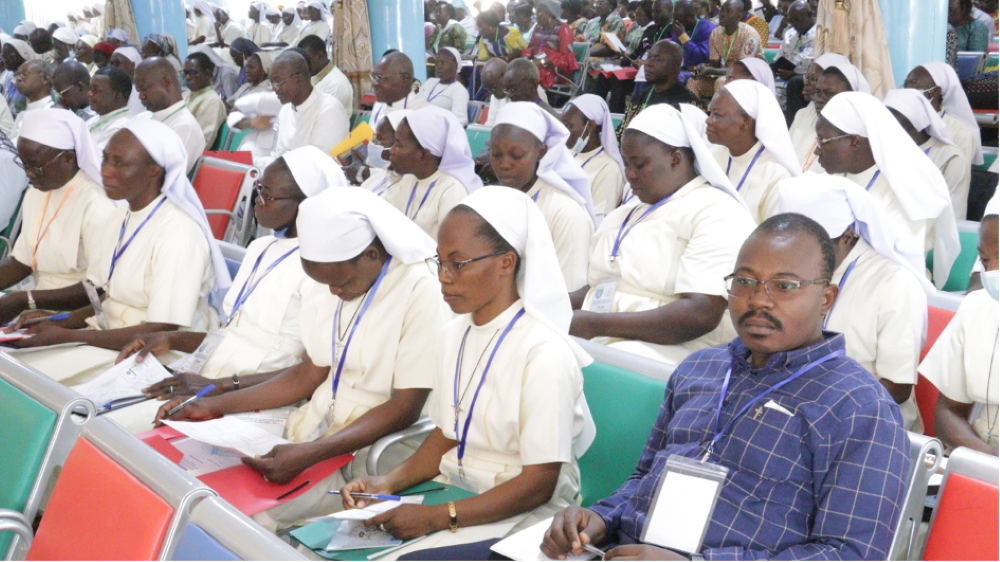
More than 600 people attended a February 2023 symposium at Gira Imana College to celebrate the 100th anniversary of the Sisters of Immaculate Conception of Ouagadougou, Burkina Faso. Attendees included Cardinal Philippe Ouagadougou, who praised the congregation for its ministry. (Josephine Gouba)
Burkina Faso, known as the "Land of Honest Men" or "Men of Integrity," is the soil in which the congregation of the Sisters of the Immaculate Conception of Ouagadougou was founded in West Africa in 1924 by Bishop Joanny Thévenoud. Thevenoud was the first apostolic vicar of the Society of the Missionaries of Africa, known as the White Fathers. He was a visionary and known for bold endeavors. The congregation has continued to attract many young girls in the country.
Filled with great joy, I became a member of these sisters on Aug. 6, 2016. Since my early childhood, I have always aspired to become a religious sister. This childhood desire. first motivated by the sisters' habit, was immediately purified when I entered the aspirate in 2004. Since then, I have understood that it's not enough to wear the religious habit to be claimed as a nun. Religious life is a total gift of oneself and a journey toward becoming a genuine Christian. During my formation time for religious life, I was fascinated by the daily life, made up of prayers and activities of all kinds.
The sisters' way of life inspired me to try and understand their roots and history so that I could make them mine. In my search, I realized that all began in 1922 in the workhouse run by the Missionary Sisters of Our Lady of Africa (the White Sisters, named such as they wore white habits and veils). The workshop was a carpet weaving industry, a novel endeavor set up by Bishop Lemaitre in order to earn income to support the sisters. He hired girls and women from the locality (Moaga) to do the work, which was supervised by the Sisters of Our Lady of Africa.
The project, in addition to generating income, also raised the status of women at this time. The project began small, set up on a narrow veranda of the convent, protected from the sun by straw mats. The first carpet was given as a gift to the local governor, who was delighted and encouraged the bishop in this creative work. It also became a curiosity to European visitors passing through Ouagadougou.
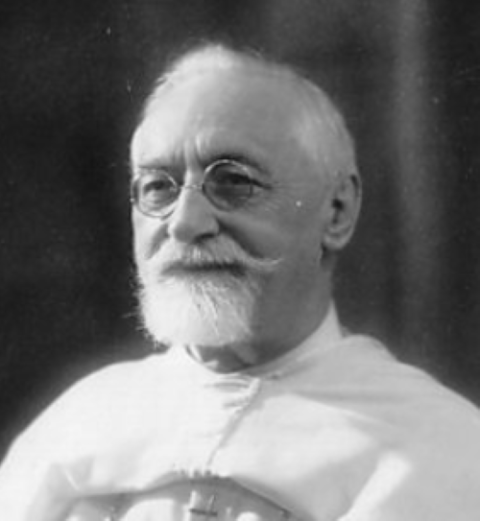
Bishop Joanny Thévenoud, founder of the Sisters of the Immaculate Conception of Ouagadougou, Burkina Faso (Courtesy of Sisters of the Immaculate Conception)
Two young workers, Marie-Jeanne Sawadogo and Marie-Thérèse, had been promised in marriage to young men from the village, but through their work with the sisters, began wondering if they could become nuns. The amazing thing was that they dared to express this desire to Sister Delphine (Marie-Thérèse Aubazac, 1885-1959), the workshop director. Driven by an unusual zeal, Sister Delphine was convinced that a religious vocation would be possible for some of the young women who worked with her. When she heard of their desire, she began discussing the possibility with Marie-Jeanne, whose daily Christian behavior suggested the possibility of a consecrated life vocation.
Marie-Jeanne was astonished and immediately replied that she truly wanted to be a sister, but did not believe that a "black" woman could become "white." Indeed, the people of the time had always seen religious life as a matter for Europeans, not Africans. Reassured by Sister Delphine, and then by Bishop Thévenoud, who was himself incredulous at first, Marie-Jeanne hastened to confide her intention to her friend Marie-Thérèse who, enthusiastic, also declared that she too was ready to give up her fiancé.
Over the years, Marie Jeanne realized her dream, making her the pioneer of the Sisters of the Immaculate Conception. Marie-Thérèse joined her in the beginning, but later left and married her fiancé. The seed sown in Voltaic soil — the name given to Burkina Faso at the beginning: Upper Volta — grew and flourished. Today, the congregation has nearly 500 living sisters and about 100 who have gone to their heavenly homeland. This makes the Sisters of the Immaculate Conception the largest Indigenous congregation in the sub-region of West Africa.
The sisters are compassionate missionaries, available for any form of apostolate deemed necessary by those in charge of the church and the institute. They work for evangelization and the good of all people, without distinction. They are present in all works of spiritual and corporal charity, such as catechesis and liturgical and pastoral ministry, care of the sick, education through pre-school, primary, secondary and professional teaching, university teaching, the promotion of women by welcoming and caring for young girls leaving forced marriage, works of mercy and social development through orphanages, training centers and help for the poor.
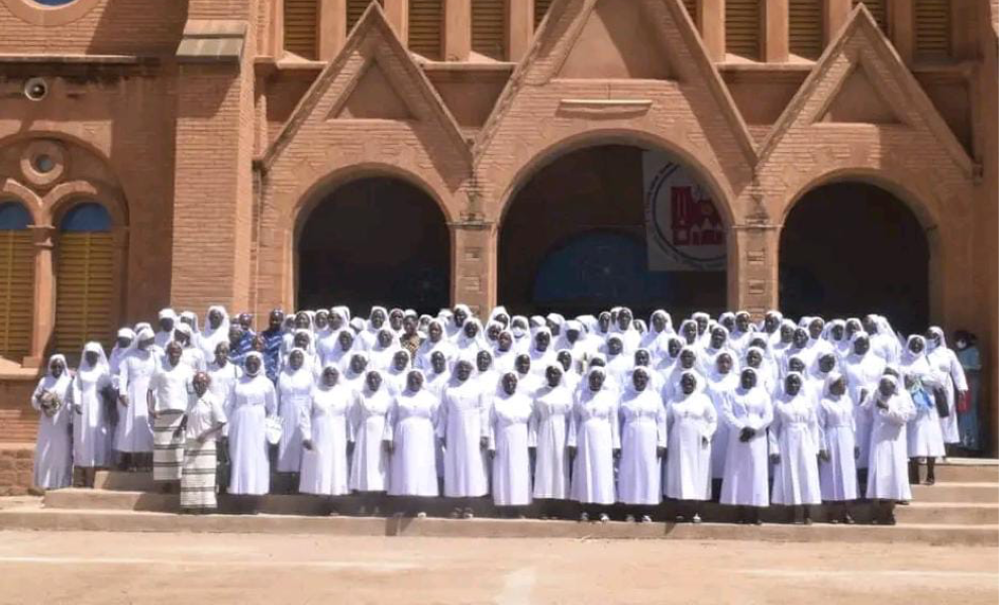
Sisters of the Immaculate Conception of Ouagadougou gather in front of Ouagadougou Cathedral in Ouagadougou, Burkina Faso, at the official opening of the congregation's jubilee in 2021. The congregation numbers about 500 sisters. (Paul Jumeau)
As Sr. Marie Ouagadougou so aptly put it in her book La Congrégation des Sœurs de l'Immaculée Conception de Ouagadougou: Cent Ans, bilan et perspectives (The Congregation of the Sisters of the Immaculate Conception of Ouagadougou: One Hundred Years, Assessment and Prospects), "Our family's mission is to reproduce everywhere and today the different aspects of the life of Jesus." The congregation has been a pontifical congregation since 1993.
The source of inspiration for Bishop Thévenoud, the founder, was the Virgin Mary. It was because of his strong devotion to her that he gave the congregation to Mary, the Immaculate Conception, as its patron saint. St. Theresa of the Holy Child Jesus is its second patron saint. Nowadays, beyond the public opinion on the sisters of the immaculate conception, we can simply say that a sister of the Immaculate Conception is a person who devotes her entire existence to God, the church and the service of her brothers and sisters.
As a full member of this institute, I work with my sisters for the glory of God and the salvation of our brothers and sisters in the world.
Advertisement
A look back at its history reminds us that the congregation, founded in 1924, is just a few steps away from celebrating its 100th anniversary. The date is set for February 2024. In the run-up to the jubilee celebrations, the sisters have undertaken many preparatory activities, including a symposium attended by more than 600 people, including Cardinal Philippe Ouagadougou. He congratulated the sisters on their missionary outings in all the parishes of the archdiocese, during which they have spoken about the congregation and the objectives of the centenary celebrations. They visited internally displaced persons and prisoners, and carried out many other activities.
We hope families will continue to encourage their daughters to consider life as women religious, totally committed to God and God's people.
